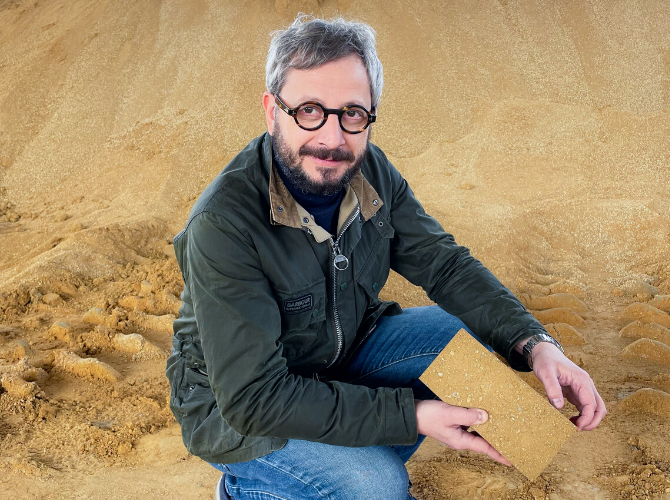Geobloc is the product of a collaboration between many players, including foremost Carrières Cloos and Neobuild. Régis Bigot, architect and innovation project manager at Neobuild, tells us more about their innovative raw earth brick and its potential to make construction more sustainable and circular.
What motivated you to found Geobloc and what problem does it tackle?
In the beginning, several ministries drew our attention to the staggering annual production of no less than eight million tons of excavated soil waste coming from all construction sites in Luxembourg. This soil usually ends up in landfills, with no other purpose than to fill holes. At the same time, the current landfills operate with operating permits that are not eternal and will no longer be suitable to collect these large masses of soil waste. This is why so many trucks cross the borders to dump these materials in our neighboring countries.
This is an economic and environmental disaster. The initial idea was to look for recycling solutions, and we quickly turned to the use of soil for the production of construction materials. To us, these materials are gold!
Nothing could have seen the light of day without Carrières Cloos who have been carrying out this project for three years now, a project that makes sense in relation to their activities.
What different products do you offer and who are they available for?
We manufacture bricks according to three standardised Luxembourg formats, in order to respond to the market and local building habits. Practically, according to the rules of the art of traditional masonry, it is thus possible to build all types of walls.
Geobloc has chosen to sell directly, “out of the factory”, in order to reduce costs. Our customers are both private individuals who wish to build by themselves and who sometimes only need a few square meters, or building companies with larger construction programs that slowly but surely reappropriate the art of building with smaller formats.
“Our current work is to raise awareness of this fantastic material, to promote its use in sustainable construction projects that use other virtuous materials […]”
Régis Bigot, architect and innovation project manager at Neobuild
It appears that your clay and soil bricks are your main product. Is that so? What makes them unique?
First, we recycle earth wrongly considered as waste, with all the benefits that flow from it in terms of the circular economy. Earth is today the only material that’s considered inexhaustible, at a time when the notion of non-renewable raw materials is prevalent and anxiety-provoking.
Secondly, we are reintroducing a material and universal know-how, which makes it possible to do a wide range of work. Raw earth brick also has extremely favorable technical characteristics: it’s free of harmful materials, infinitely recyclable and available locally, it regulates humidity, it’s dense and therefore favorable to thermal inertia, and, above all, it’s extremely favorable from an environmental point of view.
At equal volume, the energy expenditure necessary for the complete manufacturing cycle (from cradle to cradle) is about 16 times less than reinforced concrete. We are therefore faced here with a material of the future, which, through its various construction techniques, serves as the basic material for 45% of individual housing worldwide.
What is Geobloc’s main priority right now?
We are focusing today on the industrialization of the product in order to democratize it: our products are still considered expensive – although payable – but it is only because an environmental-truth cost does not yet exist. We are already seeing this gap narrowing with more conventional construction products that are energy-intensive to manufacture and/or which depend on struggling supply chains.
We are also working on the normative and regulatory aspects which are quite complex because they are inherited from very conservative industrial and societal reflexes. We are deeply committed to providing quality products, but at the same time, we have to deal with our society which no longer tolerates anything but “perfect products”.
By when can we expect full houses to be built with Geoblocs?
This is the question I ask my fellow architects because everything is ready for this path. This requires longer project development work, but examples already exist outside our country. We are very excited by this idea and I hope that the policy of small steps that we operate on will lead to more ambitious projects. I have no doubt that within two to three years, a pilot project entirely built in mud bricks will be operational.
Today, most current projects make use of Geobloc for the construction of interior partitions or lining walls and we can count on the support of large pioneering companies such as CDCL, Soludec or Dellizotti, without forgetting the support of the IFSB, to show the way with this material, because they understood all the meaning.
What are the next steps for Geobloc and how do you see the company evolving in the future?
Our current work is to raise awareness of this fantastic material, to promote its use in sustainable construction projects that use other virtuous materials with which the earth works wonderfully, and, of course, to win new orders. I am personally convinced that alongside raw earth, Luxembourg is ready for the redeployment of new industrial sectors – clean and efficient – useful for its economic development and its autonomy in the construction products market.
